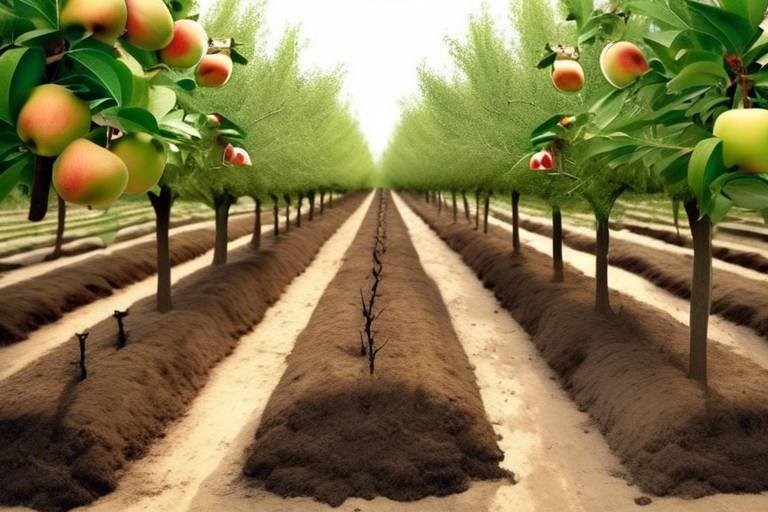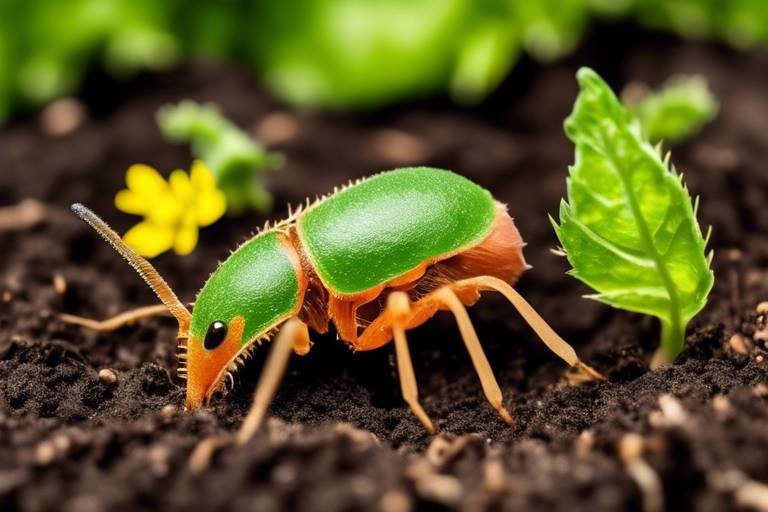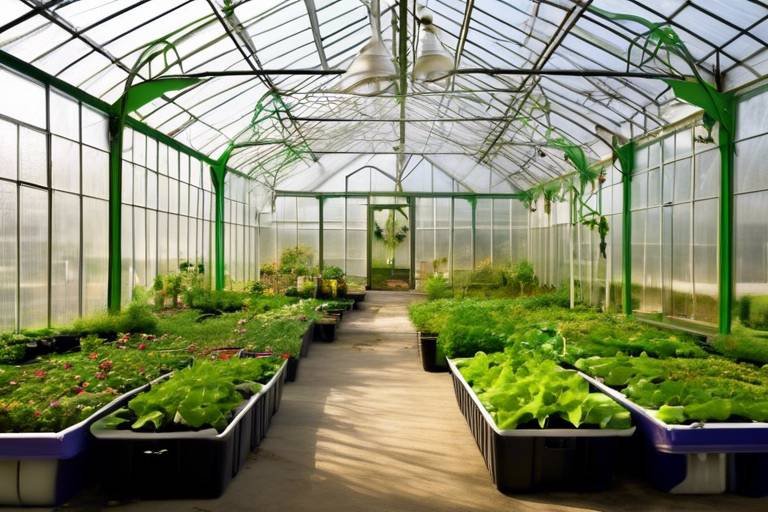Pros and Cons of Eco-Friendly Farming - A Complete Guide
Eco-friendly farming is not just a trend; it’s a movement that’s reshaping the agricultural landscape. As we dive into this topic, it’s essential to understand that eco-friendly farming practices aim to create a sustainable and harmonious relationship between agriculture and the environment. This guide will explore both the advantages and disadvantages of these practices, providing insights that can help farmers, consumers, and policymakers make informed decisions.
At its core, eco-friendly farming revolves around sustainable practices designed to minimize environmental harm. This includes methods such as organic farming, which avoids synthetic fertilizers and pesticides, and permaculture, which focuses on creating self-sustaining agricultural ecosystems. Another critical aspect is regenerative agriculture, which aims to restore soil health and biodiversity. These principles are becoming increasingly vital as we face climate change and the degradation of natural resources.
The benefits of eco-friendly farming are numerous and impactful. For starters, it significantly improves soil health, which is the backbone of any successful agricultural practice. Healthy soil not only leads to better crop yields but also enhances resilience against pests and diseases. Additionally, eco-friendly farming promotes biodiversity, supporting various plant and animal species that contribute to a balanced ecosystem. By reducing chemical usage, these practices also lead to cleaner water sources and healthier food options for consumers.
One of the most compelling aspects of eco-friendly farming is its positive environmental impact. By adopting sustainable practices, farmers can drastically reduce pollution and conserve precious natural resources. For example, techniques like crop rotation and cover cropping help in soil conservation, while efficient water management practices ensure that water resources are used wisely. Moreover, reducing the carbon footprint through organic farming methods contributes to a healthier planet.
Healthy soil is the foundation of sustainable agriculture. Eco-friendly practices such as composting, reduced tillage, and organic amendments can significantly enhance soil fertility and structure. This not only promotes better crop yields but also creates a resilient ecosystem capable of withstanding environmental stressors. When soil is rich in organic matter, it retains moisture better, reduces erosion, and supports a diverse array of microorganisms that are crucial for nutrient cycling.
Biodiversity is essential for maintaining ecosystem stability. Eco-friendly farming practices support diverse plant and animal species, which in turn fosters a balanced environment. For instance, planting a variety of crops can attract beneficial insects and pollinators, reducing the need for chemical pesticides. This symbiotic relationship between agriculture and wildlife not only benefits the ecosystem but also enhances the overall productivity of the farm.
While the benefits of eco-friendly farming are clear, it’s important to acknowledge the economic challenges that come with it. Transitioning to sustainable practices often requires significant upfront investment. Farmers may need to purchase organic seeds, invest in new equipment, or even undergo training to learn about sustainable methods. Additionally, accessing markets for eco-friendly products can be challenging, as consumer awareness and demand may not yet align with the supply.
Despite its many advantages, eco-friendly farming does face several challenges. These include higher initial costs, limited access to resources, and resistance from conventional farming communities. It’s crucial to provide a balanced view of sustainable agriculture, as understanding these challenges can help in developing solutions that benefit both farmers and the environment.
Transitioning to eco-friendly farming often requires a significant upfront investment. Farmers may face financial barriers, such as the cost of organic certification, purchasing new seeds, or investing in sustainable farming equipment. However, there are potential solutions to mitigate these costs, such as government grants, subsidies, and cooperative buying programs that can help ease the financial burden.
Accessing markets for eco-friendly products can be another hurdle. Farmers may struggle with consumer awareness or the complexities of certification processes that can be time-consuming and costly. Building local markets and increasing consumer education about the benefits of eco-friendly products can play a significant role in supporting farmers who choose sustainable practices.
- What is eco-friendly farming? Eco-friendly farming refers to agricultural practices that aim to minimize harm to the environment while promoting sustainability.
- What are the benefits of eco-friendly farming? Benefits include improved soil health, biodiversity conservation, reduced chemical usage, and a lower carbon footprint.
- What challenges do eco-friendly farmers face? Challenges include higher initial investment costs, limited market access, and resistance from conventional farming communities.
- How can consumers support eco-friendly farming? Consumers can support eco-friendly farming by purchasing organic products, advocating for sustainable practices, and educating themselves about the benefits of eco-friendly agriculture.

Understanding Eco-Friendly Farming
This article explores the advantages and disadvantages of eco-friendly farming practices, providing insights into their impact on the environment, economy, and food production, helping readers make informed decisions.
Eco-friendly farming is more than just a trend; it's a vital approach to agriculture that emphasizes sustainability and environmental stewardship. At its core, eco-friendly farming involves practices that aim to reduce harm to the planet while promoting healthy food production. This approach encompasses several principles, including organic farming, permaculture, and regenerative agriculture.
Organic farming is perhaps the most recognized form of eco-friendly agriculture. It avoids synthetic fertilizers and pesticides, opting instead for natural alternatives that enhance soil health and biodiversity. By nurturing the land rather than depleting it, organic farming not only produces healthier crops but also contributes to the overall well-being of the ecosystem.
Permaculture takes this a step further by designing agricultural systems that mimic natural ecosystems. It focuses on creating self-sustaining environments where plants, animals, and humans work together harmoniously. Imagine a garden where every element supports another—plants provide shade for one another, while animals contribute to soil fertility through their natural behaviors. This interconnectedness is the essence of permaculture.
Regenerative agriculture, on the other hand, aims to restore degraded soils and ecosystems. It employs techniques such as cover cropping, crop rotation, and holistic grazing to revitalize the land. The goal is not just to sustain the current state of the environment but to improve it, making it more resilient against climate change and other challenges.
These eco-friendly practices are crucial in today's agricultural landscape for several reasons:
- Environmental Protection: They significantly reduce pollution and conserve natural resources.
- Soil Health: They enhance soil fertility and structure, promoting better crop yields.
- Biodiversity: They support diverse plant and animal species, fostering a balanced environment.
Understanding these principles is essential for anyone interested in sustainable agriculture. By adopting eco-friendly farming practices, farmers can contribute to a healthier planet while also reaping the benefits of improved crop yields and reduced input costs in the long run. It’s a win-win situation that not only supports the environment but also enhances food security for future generations.
Here are some common questions regarding eco-friendly farming:
- What is the main goal of eco-friendly farming? The primary aim is to produce food in a way that is sustainable and less harmful to the environment.
- How does eco-friendly farming impact biodiversity? It promotes a diverse range of species, which is essential for a balanced ecosystem.
- Are eco-friendly products more expensive? While initial costs may be higher, the long-term benefits often outweigh these expenses.

Benefits of Eco-Friendly Farming
Eco-friendly farming practices are not just a trend; they are a vital part of creating a sustainable future for our planet. By focusing on methods that prioritize the health of the environment, these practices offer numerous advantages that can positively impact both agriculture and society as a whole. Let's dive into some of the most significant benefits that come with adopting eco-friendly farming.
First and foremost, eco-friendly farming enhances soil health. Healthy soil is like the backbone of agriculture; it supports plant growth and contributes to the overall resilience of crops. When farmers use organic fertilizers, crop rotations, and cover crops, they improve soil structure and fertility. This not only leads to better yields but also helps in retaining moisture, which is crucial during dry spells. In fact, studies show that farms practicing eco-friendly methods can see a 30% increase in soil organic matter compared to conventional farms.
Another major benefit is the promotion of biodiversity. Eco-friendly farming practices encourage a variety of crops and livestock, which in turn supports a diverse range of insects, birds, and other wildlife. This biodiversity is essential for a balanced ecosystem, as it helps control pests naturally, reduces the risk of crop failure, and enhances pollination. By fostering a rich tapestry of life on their farms, eco-friendly farmers are essentially creating a small ecosystem that benefits both their crops and the environment.
Moreover, eco-friendly farming significantly reduces chemical usage. Traditional farming often relies heavily on synthetic fertilizers and pesticides, which can lead to soil degradation, water pollution, and health risks for consumers. In contrast, eco-friendly practices utilize natural alternatives that are less harmful to the environment. This shift not only protects our water sources but also leads to healthier food options for consumers. Imagine biting into a juicy tomato, knowing it was grown without harmful chemicals—now that’s a win-win!
Additionally, eco-friendly farming can contribute to climate change mitigation. By adopting practices like agroforestry and reduced tillage, farmers can sequester carbon dioxide in the soil, helping to combat the greenhouse gases that contribute to global warming. This not only benefits the planet but can also enhance the farmer’s reputation as a steward of the environment, attracting eco-conscious consumers and potentially leading to higher sales.
Lastly, eco-friendly farming practices can lead to economic resilience. While the initial investment may be higher, the long-term benefits include reduced input costs and access to premium markets. Consumers are increasingly willing to pay more for sustainably produced goods, which means that eco-friendly farmers can often command better prices for their products. This economic shift not only supports the farmers but also promotes a more sustainable food system overall.
In summary, the benefits of eco-friendly farming are numerous and profound. From improving soil health and promoting biodiversity to reducing chemical usage and contributing to climate change mitigation, these practices offer a roadmap to a more sustainable and resilient agricultural future. As we continue to face environmental challenges, the importance of eco-friendly farming cannot be overstated. It’s time for farmers and consumers alike to embrace these practices for a healthier planet and a more sustainable food system.
- What is eco-friendly farming? Eco-friendly farming refers to agricultural practices that prioritize sustainability and environmental health, minimizing the use of harmful chemicals and promoting biodiversity.
- How does eco-friendly farming benefit the environment? It reduces pollution, conserves natural resources, and enhances soil health, leading to a healthier ecosystem.
- Can eco-friendly farming be profitable? Yes, while initial costs may be higher, eco-friendly farming can lead to reduced input costs and access to premium markets, enhancing profitability in the long run.
- What are some common eco-friendly farming practices? Common practices include organic farming, permaculture, crop rotation, and agroforestry.

Environmental Impact
The environmental impact of eco-friendly farming practices is profound and multifaceted. By prioritizing sustainability, these methods aim to mitigate the negative effects of traditional agriculture on our planet. One of the most significant advantages is the reduction of pollution. Conventional farming often relies on chemical fertilizers and pesticides, which can leach into waterways, harming aquatic ecosystems and contaminating drinking water supplies. In contrast, eco-friendly farming minimizes or completely eliminates the use of these harmful substances, promoting a cleaner environment.
Additionally, eco-friendly farming practices contribute to the conservation of natural resources. For instance, techniques such as crop rotation and cover cropping enhance soil health, which in turn increases its ability to retain water. This is crucial in areas prone to drought, where water scarcity can severely impact food production. Moreover, sustainable farming methods like agroforestry integrate trees into agricultural landscapes, which not only improves biodiversity but also aids in carbon sequestration, helping to combat climate change.
To illustrate the impact of eco-friendly farming on the environment, consider the following table that highlights key benefits:
| Benefit | Description |
|---|---|
| Soil Conservation | Enhances soil structure and fertility, reducing erosion and promoting healthy crops. |
| Water Management | Improves water retention and reduces runoff, ensuring sustainable water use. |
| Reduced Carbon Footprint | Minimizes greenhouse gas emissions through sustainable practices. |
Furthermore, eco-friendly farming promotes biodiversity, which is essential for a balanced ecosystem. By fostering diverse plant and animal species, these practices create a resilient agricultural landscape. This biodiversity not only supports pollinators, which are critical for crop production, but also helps in pest control, reducing the need for chemical interventions. Imagine a farm buzzing with life, where flowers bloom, insects thrive, and birds sing—a vibrant ecosystem that enhances productivity while maintaining ecological balance.
In conclusion, the environmental impact of eco-friendly farming is overwhelmingly positive. By reducing pollution, conserving resources, and promoting biodiversity, these sustainable practices pave the way for a healthier planet. As we face pressing environmental challenges, supporting eco-friendly farming is not just beneficial for farmers; it is essential for the future of our food systems and the well-being of our planet.
- What is eco-friendly farming? Eco-friendly farming refers to agricultural practices that are sustainable and minimize harm to the environment.
- How does eco-friendly farming reduce pollution? By eliminating or reducing the use of chemical fertilizers and pesticides, eco-friendly farming practices help keep waterways clean.
- What are some examples of eco-friendly farming practices? Examples include organic farming, permaculture, and regenerative agriculture.
- Can eco-friendly farming be profitable? Yes, while there may be initial investment costs, eco-friendly farming can lead to long-term profitability through sustainable practices and market demand for organic products.

Soil Health
Healthy soil is the bedrock of sustainable agriculture, acting as a living ecosystem that supports plant growth and promotes biodiversity. When we talk about eco-friendly farming, it's essential to recognize how these practices enhance soil health. Think of soil as a sponge; when it's healthy, it retains water and nutrients efficiently, providing crops with the essential elements they need to thrive. On the flip side, degraded soil can lead to poor crop yields and increased vulnerability to pests and diseases.
One of the core principles of eco-friendly farming is to improve soil fertility and structure through natural methods. For example, techniques such as crop rotation, cover cropping, and the use of organic fertilizers enrich the soil organically, enhancing its nutrient profile without the harmful side effects of synthetic chemicals. This not only boosts the productivity of the land but also contributes to a more resilient farming system. By fostering a rich microbial community, healthy soil can better resist erosion, retain moisture, and even sequester carbon, helping mitigate climate change.
Moreover, eco-friendly practices like composting and reduced tillage can significantly improve soil structure. When soil is not overly disturbed, it allows for better air and water infiltration, which is vital for root development. The following benefits highlight why maintaining soil health is crucial in eco-friendly farming:
- Increased Nutrient Availability: Healthy soil has a diverse range of microorganisms that help break down organic matter, making nutrients more accessible to plants.
- Enhanced Water Retention: Well-structured soil can absorb and hold more water, reducing the need for irrigation and helping crops survive dry spells.
- Pest and Disease Resistance: A robust ecosystem within the soil can naturally regulate pests and diseases, reducing the need for chemical interventions.
In summary, the health of the soil is not just a factor in crop production; it’s a vital component of the entire ecosystem. By adopting eco-friendly farming practices, farmers can cultivate soil that supports not only their crops but also the broader environment. This interconnectedness underscores the importance of viewing soil health as an integral part of sustainable agriculture, ensuring that we can produce food without compromising the planet's health for future generations.
What are the signs of healthy soil?
Healthy soil typically has a dark color, a crumbly texture, and a variety of organisms such as earthworms and microorganisms. It should also retain moisture without becoming waterlogged.
How can farmers improve soil health?
Farmers can improve soil health through practices like crop rotation, cover cropping, composting, and minimizing tillage. These methods enhance the soil's organic matter and microbial activity.
Why is soil health important for the environment?
Healthy soil plays a crucial role in carbon sequestration, water filtration, and supporting biodiversity. It helps mitigate climate change and protects water quality, making it essential for a sustainable future.

Biodiversity Conservation
Biodiversity is not just a buzzword; it’s the lifeblood of our ecosystems and a crucial component of sustainable agriculture. When we talk about eco-friendly farming, we’re really highlighting practices that work in harmony with nature, ensuring that diverse plant and animal species can thrive. Imagine a vibrant tapestry of life, where every thread—be it the tiniest insect or the tallest tree—plays a vital role in maintaining the balance of our environment. This is what biodiversity conservation in eco-friendly farming aims to achieve.
One of the most significant benefits of eco-friendly farming is its ability to foster biodiversity. Traditional farming methods often lead to monocultures, where a single crop is grown over vast areas. This practice not only depletes the soil but also makes crops more vulnerable to pests and diseases. In contrast, eco-friendly farming encourages crop rotation, intercropping, and the use of cover crops, which can enhance soil health and create habitats for various species. By promoting a diverse range of crops and animals, farmers can create a more resilient ecosystem that can better withstand environmental changes.
Moreover, eco-friendly practices like organic farming and permaculture emphasize the importance of native species. Native plants and animals are adapted to local conditions and play essential roles in pollination, pest control, and nutrient cycling. For instance, planting native wildflowers can attract beneficial insects, such as bees and butterflies, which are critical for pollinating many of our food crops. By supporting these species, farmers not only enhance their productivity but also contribute to the overall health of the environment.
The impact of biodiversity conservation extends beyond the farm. Healthy ecosystems provide essential services that benefit society as a whole. These services include clean air and water, climate regulation, and soil fertility. By preserving biodiversity, eco-friendly farmers are essentially investing in the future of our planet. They are creating a sustainable model that not only produces food but also nurtures the environment. In this way, biodiversity conservation is not just an ethical choice; it’s a practical one that supports long-term agricultural productivity and ecological health.
However, it’s essential to recognize that promoting biodiversity is not without its challenges. Farmers may face obstacles such as limited access to diverse seeds or knowledge about sustainable practices. To overcome these hurdles, collaboration between farmers, researchers, and policymakers is vital. Educational programs and resources can empower farmers to adopt practices that enhance biodiversity on their farms. By working together, we can create a future where agriculture and nature coexist harmoniously, ensuring that both thrive for generations to come.
In conclusion, biodiversity conservation is a cornerstone of eco-friendly farming that benefits not only farmers but also the broader ecosystem. As we move towards more sustainable agricultural practices, embracing biodiversity will be crucial in creating resilient food systems. By recognizing the interconnectedness of all living things, we can cultivate a farming landscape that is rich in diversity, productivity, and sustainability.
- What is biodiversity conservation in farming?
Biodiversity conservation in farming refers to practices that promote a variety of plant and animal species within agricultural systems, enhancing ecosystem health and resilience.
- How does eco-friendly farming support biodiversity?
Eco-friendly farming practices, such as crop rotation and intercropping, create diverse habitats that support a wide range of species, contributing to a balanced ecosystem.
- Why is biodiversity important for agriculture?
Biodiversity is crucial for agriculture as it helps maintain soil health, supports pest control, and enhances pollination, leading to improved crop yields and resilience against diseases.
- What challenges do farmers face in promoting biodiversity?
Farmers may encounter challenges such as limited access to diverse seeds, lack of knowledge about sustainable practices, and financial constraints when trying to promote biodiversity on their farms.

Economic Considerations
When diving into the world of eco-friendly farming, it's essential to consider the economic implications that come with adopting these sustainable practices. While the benefits to the environment and health are significant, the financial aspects can sometimes feel like a double-edged sword. For many farmers, transitioning to eco-friendly methods can mean facing higher initial investment costs, which can be daunting. Think of it like buying a new car; while the upfront price might be steep, the long-term savings on fuel and maintenance can make it worthwhile.
One of the primary economic challenges is the cost of transitioning from conventional to eco-friendly practices. Farmers may need to invest in new equipment, organic seeds, and sustainable pest management solutions. This initial outlay can be a barrier, especially for smaller farms operating on tight budgets. However, it's crucial to recognize that these costs can lead to long-term savings and benefits, such as reduced reliance on expensive chemical fertilizers and pesticides.
Moreover, the market for eco-friendly products is growing, but accessing these markets can be tricky. Farmers often find themselves navigating a maze of certification processes to prove their products are organic or sustainably produced. This can be time-consuming and costly, but it is a necessary step to ensure that consumers trust the eco-friendly label. Additionally, consumer awareness plays a significant role in market accessibility. As more people become conscious of their food choices, the demand for eco-friendly products continues to rise, creating opportunities for farmers willing to adapt.
Another economic consideration is the potential for profitability. While the initial costs may be high, many eco-friendly products can command premium prices in the market. Consumers are often willing to pay more for organic or sustainably sourced goods, which can lead to higher profit margins for farmers. However, this potential profitability is not guaranteed and can depend on various factors, including local market conditions and consumer preferences.
Ultimately, the economic landscape of eco-friendly farming is complex and multifaceted. Farmers must weigh the initial costs against the long-term benefits, considering factors like market access and consumer demand. To help visualize these considerations, here’s a simple table comparing the initial costs and potential long-term benefits:
| Cost/Benefit | Initial Investment | Long-Term Benefit |
|---|---|---|
| Organic Seeds | Higher | Better quality crops |
| Sustainable Equipment | Higher | Reduced maintenance costs |
| Certification Fees | Moderate | Access to premium markets |
| Consumer Awareness | Variable | Increased sales potential |
In conclusion, while eco-friendly farming presents various economic challenges, it also offers substantial long-term benefits that can lead to a more sustainable and profitable agricultural future. Farmers who take the leap into eco-friendly practices may find themselves not just contributing to a healthier planet, but also discovering new avenues for financial success.
- What are the main costs associated with eco-friendly farming? The primary costs include organic seeds, sustainable equipment, and certification fees.
- Is eco-friendly farming more profitable in the long run? Yes, while initial costs may be higher, eco-friendly products often command premium prices, leading to potentially higher profit margins.
- How can farmers access markets for eco-friendly products? Farmers can improve market access by obtaining necessary certifications and increasing consumer awareness through marketing efforts.

Challenges of Eco-Friendly Farming
While eco-friendly farming offers a plethora of benefits, it is not without its challenges. Transitioning to sustainable practices can feel like navigating a maze, filled with obstacles that can deter even the most passionate farmers. One of the most significant hurdles is the initial investment cost. Farmers often face substantial upfront expenses when switching from conventional to eco-friendly methods. This transition can include costs for organic seeds, eco-friendly pesticides, and specialized equipment. For many, this financial burden can be daunting, leading to hesitation in adopting sustainable practices.
Moreover, the economic landscape can be unpredictable. Farmers may find themselves in a catch-22 situation, where the initial costs deter them from making the switch, yet the long-term benefits are hard to ignore. To illustrate, consider the following table, which outlines the typical costs associated with transitioning to eco-friendly farming:
| Item | Estimated Cost |
|---|---|
| Organic Seeds | $200 - $500 per acre |
| Eco-Friendly Pesticides | $100 - $300 per acre |
| Soil Testing | $50 - $150 |
| Certification Fees | $1,000 - $2,500 |
Another significant challenge is market accessibility. Eco-friendly farmers often struggle to find markets for their products, as consumer awareness and demand for sustainable goods can vary widely. Without a solid consumer base, farmers may find it difficult to sell their produce at a price that reflects the higher costs of eco-friendly farming. The certification processes can also be a barrier, as they often require time and resources that many small-scale farmers simply do not have.
Additionally, there can be a strong resistance from conventional farming communities. This resistance often stems from a lack of understanding or misinformation about the benefits of sustainable practices. Farmers who wish to transition may feel isolated, facing skepticism from peers who have always farmed the traditional way. This social dynamic can create a challenging environment for those eager to embrace eco-friendly methods.
In conclusion, while eco-friendly farming presents a promising path toward sustainable agriculture, it is essential to recognize the challenges that accompany this transition. By understanding these hurdles, farmers, policymakers, and consumers can work together to foster a more supportive environment for sustainable practices. This collaboration can pave the way for a future where eco-friendly farming is not just a choice but a standard in agricultural practices.
- What are the main challenges of eco-friendly farming? The primary challenges include high initial investment costs, limited market access, and resistance from conventional farming communities.
- How can farmers overcome the financial barriers? Farmers can explore grants, subsidies, and cooperative models to share resources and reduce costs.
- Is there a demand for eco-friendly products? Yes, but it varies by region. Consumer awareness is growing, leading to increased demand for sustainable products.
- What role do certifications play? Certifications can help consumers identify eco-friendly products but can also pose challenges due to their costs and complexity.

Initial Investment Costs
Transitioning to eco-friendly farming often requires a significant upfront investment that can be a daunting hurdle for many farmers. Imagine you’re standing at a crossroads: on one path lies the familiar terrain of conventional farming, where the costs are predictable, and on the other, the uncharted territory of sustainable practices that promise long-term benefits but demand immediate financial commitment. This initial investment can encompass various aspects, such as purchasing organic seeds, investing in sustainable pest control methods, or upgrading equipment to reduce environmental impact.
For many farmers, the first step toward eco-friendly farming may involve a hefty price tag. For instance, organic seeds can be more expensive than their conventional counterparts, and the shift to natural fertilizers often requires new sourcing strategies. Additionally, the adoption of practices like crop rotation and cover cropping not only enhances soil health but also necessitates changes in planting schedules and equipment, which can further increase costs.
To provide a clearer picture, let’s break down some of the common expenses associated with transitioning to eco-friendly farming:
| Expense Category | Estimated Cost |
|---|---|
| Organic Seeds | $200 - $500 per acre |
| Sustainable Pest Control | $100 - $300 per acre |
| Soil Amendments | $150 - $400 per acre |
| Equipment Upgrades | $1,000 - $10,000 |
These costs can add up quickly, making it essential for farmers to evaluate their financial situation thoroughly before embarking on this journey. However, it’s important to remember that while the initial investment may seem substantial, the long-term benefits—such as reduced input costs, improved crop resilience, and access to premium markets—can lead to greater profitability over time.
Moreover, there are various options available to help mitigate these costs. Government grants, subsidies, and loans specifically designed for sustainable agriculture can provide much-needed financial support. Additionally, collaborating with local agricultural organizations can open doors to shared resources and knowledge, making the transition smoother and less financially burdensome.
In conclusion, while the initial investment costs of eco-friendly farming can be a significant barrier, understanding the potential long-term benefits and exploring financial assistance options can empower farmers to make informed decisions. Embracing sustainable practices not only contributes to a healthier planet but can also pave the way for a more resilient and profitable farming future.
- What are the main financial barriers to eco-friendly farming? The main barriers include the high initial costs of organic inputs, equipment upgrades, and the need for new farming practices.
- Are there financial incentives for farmers transitioning to eco-friendly practices? Yes, many governments offer grants, subsidies, and low-interest loans to support sustainable agriculture.
- How can farmers reduce the initial investment costs? Farmers can collaborate with local organizations, access shared resources, and seek financial assistance programs designed for sustainable practices.

Market Accessibility
Accessing markets for eco-friendly products can be a daunting task for many farmers. While the demand for sustainable and organic products is on the rise, the pathways to successfully reaching consumers are often fraught with challenges. One of the primary hurdles is consumer awareness. Many consumers are still unaware of the benefits of eco-friendly products, leading to a lack of demand in certain regions. Farmers often find themselves in a situation where they are producing high-quality, sustainable goods, but the market simply isn't there to support them.
Furthermore, the certification processes required for eco-friendly farming can be both time-consuming and costly. Farmers must navigate a maze of regulations and standards to obtain certifications that validate their practices. This not only requires a financial investment but also a significant amount of time and effort. For many small-scale farmers, this can be a dealbreaker. They might find themselves questioning whether the effort is worth the potential return, especially when conventional farming methods seem to offer a quicker, less complicated path to market.
Local markets play a crucial role in enhancing market accessibility for eco-friendly farmers. Farmers' markets, community-supported agriculture (CSA) programs, and local grocery stores that prioritize local and sustainable products can provide a more direct route to consumers. Engaging with the community and building relationships can help farmers establish a loyal customer base that values sustainable practices. However, this requires a proactive approach to marketing and outreach, which can be overwhelming for farmers already stretched thin by the demands of their operations.
In addition to local markets, online sales platforms have emerged as a viable alternative for eco-friendly farmers. E-commerce allows farmers to reach a broader audience beyond their immediate geographical location. By leveraging social media and online marketing strategies, farmers can showcase their products and connect with consumers who are passionate about sustainability. However, establishing an online presence also comes with its own set of challenges, including the need for technical skills and the ability to manage logistics effectively.
Ultimately, the journey to market accessibility in eco-friendly farming is multifaceted and requires a blend of education, community engagement, and strategic marketing. As the demand for sustainable agriculture continues to grow, addressing these challenges will be essential for ensuring that eco-friendly farmers can thrive in a competitive marketplace.
- What are the main challenges eco-friendly farmers face in accessing markets?
Eco-friendly farmers often encounter challenges such as consumer awareness, complicated certification processes, and limited access to local and online markets.
- How can farmers improve their market accessibility?
Farmers can enhance their market accessibility by engaging in local markets, utilizing online sales platforms, and building strong relationships within their communities.
- Is consumer awareness important for the success of eco-friendly farming?
Yes, consumer awareness is crucial as it drives demand for eco-friendly products. Educating consumers about the benefits of sustainable agriculture can help increase market opportunities for farmers.
Frequently Asked Questions
- What is eco-friendly farming?
Eco-friendly farming refers to agricultural practices that prioritize sustainability and environmental health. This includes methods like organic farming, permaculture, and regenerative agriculture, all aimed at reducing harm to the ecosystem while promoting biodiversity and soil health.
- What are the benefits of eco-friendly farming?
There are numerous benefits to eco-friendly farming, such as improved soil health, enhanced biodiversity, and reduced reliance on harmful chemicals. These practices contribute to a more sustainable food system and can lead to healthier ecosystems, making it a win-win for both farmers and consumers.
- How does eco-friendly farming impact the environment?
Eco-friendly farming significantly reduces pollution and conserves natural resources. By implementing sustainable practices, farmers can enhance soil conservation, manage water resources more effectively, and lower their carbon footprint, ultimately contributing to a healthier planet.
- Is eco-friendly farming more expensive?
While eco-friendly farming can involve higher initial investment costs, it often leads to long-term savings and benefits. Farmers may face financial barriers when transitioning, but the potential for increased profitability and market demand for sustainable products can offset these costs over time.
- How can consumers support eco-friendly farming?
Consumers can support eco-friendly farming by choosing to buy organic and sustainably produced products. Being aware of certification processes and supporting local farmers' markets can also help create a demand for eco-friendly practices, encouraging more farmers to adopt them.
- What challenges do eco-friendly farmers face?
Eco-friendly farmers often encounter challenges such as higher costs, limited access to resources, and resistance from conventional farming communities. Addressing these challenges requires collaboration, education, and increased consumer awareness to create a more supportive environment for sustainable agriculture.



















